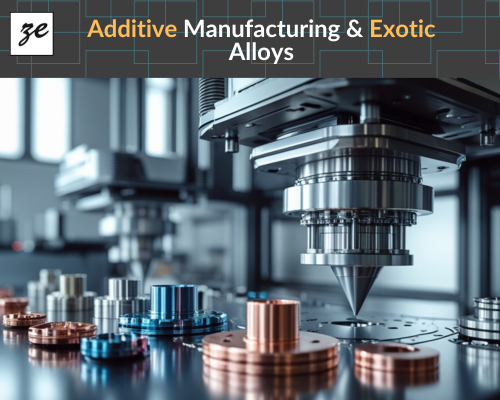Additive Manufacturing and Exotic Alloys: Opportunities and Challenges
Additive Manufacturing (AM), commonly known as 3D printing, has revolutionized the way industries approach production. By enabling the layer-by-layer construction of parts, AM offers unparalleled design flexibility and material efficiency. When combined with exotic alloys, which are engineered for high-performance applications, the potential for innovation expands significantly. This article delves into the opportunities and challenges presented by the integration of AM and exotic alloys, with a particular focus on Zeon Exports, a leading supplier of duplex and super duplex steels, nickel alloys, and other exotic materials.
Understanding Additive Manufacturing
Additive Manufacturing encompasses various processes where material is deposited layer by layer to build a part from a digital model. Unlike traditional subtractive manufacturing methods, AM allows for the creation of complex geometries that were previously challenging or impossible to achieve. This capability is particularly beneficial in industries such as aerospace, automotive, and healthcare, where lightweight and intricate components are essential.
Exotic Alloys: The Backbone of High-Performance Applications
Exotic alloys, also known as superalloys, are materials designed to withstand extreme conditions, including high temperatures, corrosion, and wear. These alloys often contain elements like nickel, cobalt, and titanium, which impart unique properties. For instance, Inconel 718, a nickel-based alloy, is renowned for its high-temperature strength and resistance to oxidation, making it ideal for turbine blades and aerospace components. Similarly, alloys like Alloy 2507 and Alloy 904L, available through Zeon Exports, are known for their exceptional corrosion resistance, suitable for chemical processing and marine environments.
Opportunities at the Intersection of AM and Exotic Alloys
1. Design Freedom and Complex Geometries
AM allows for the production of parts with intricate designs that traditional manufacturing methods cannot achieve. This capability is particularly advantageous when working with exotic alloys, as it enables the creation of components with optimized structures, reducing weight without compromising strength. Zeon Exports' extensive inventory of exotic alloys provides the necessary materials to realize these advanced designs.
2. Rapid Prototyping and Reduced Lead Times
The iterative nature of AM facilitates rapid prototyping, allowing for quick testing and refinement of designs. This is especially beneficial when working with exotic alloys, as it accelerates the development process and reduces the time from concept to production. Zeon Exports' large stock holdings ensure timely availability of materials, further expediting the manufacturing process.
3. Material Efficiency and Waste Reduction
Traditional manufacturing methods often result in significant material waste due to the subtractive nature of the processes. AM, on the other hand, is an additive process, meaning material is deposited only where needed, leading to minimal waste. This is particularly important when working with costly exotic alloys, as it enhances material utilization and reduces overall costs.
4. Customization and Tailored Properties
AM enables the customization of components to meet specific requirements, such as tailored mechanical properties or geometric configurations. By selecting appropriate exotic alloys, manufacturers can produce parts with properties precisely suited to their applications, enhancing performance and longevity.
Challenges in Integrating AM with Exotic Alloys
1. Material Behavior and Process Control
The unique properties of exotic alloys can lead to unpredictable behavior during the AM process. Factors such as thermal gradients, cooling rates, and phase transformations can affect the final microstructure and mechanical properties of the part. Achieving consistent results requires precise control over processing parameters and a deep understanding of material science.
2. Equipment and Expertise Requirements
AM of exotic alloys often necessitates specialized equipment capable of handling high-temperature materials and maintaining stringent process controls. Additionally, operators must possess expertise in both AM technologies and the specific characteristics of the alloys being used. This combination of advanced machinery and skilled personnel can present a barrier to widespread adoption.
3. Post-Processing Challenges
Parts produced via AM often require post-processing steps such as heat treatment, surface finishing, and machining to achieve desired properties and tolerances. The hardness and strength of exotic alloys can make these post-processing steps more challenging, potentially leading to increased costs and extended lead times.
4. Cost Considerations
The combination of high-performance exotic alloys and advanced AM technologies can result in elevated production costs. While the benefits of reduced material waste and design flexibility are significant, the initial investment in equipment and the cost of specialized materials must be carefully considered.
Zeon Exports: Pioneering the Future of AM with Exotic Alloys
Zeon Exports stands at the forefront of supplying high-quality exotic alloys, offering a comprehensive range of materials including duplex and super duplex steels, nickel alloys, and other specialized alloys. Their extensive inventory and commitment to quality ensure that manufacturers have access to the materials necessary for advanced AM applications.
By partnering with Zeon Exports, companies can leverage their expertise and resources to navigate the complexities of integrating AM with exotic alloys. Whether it's selecting the appropriate material for a specific application or optimizing the AM process for desired outcomes, Zeon Exports provides the support needed to succeed in this evolving field.
Conclusion
The synergy between Additive Manufacturing and exotic alloys opens new avenues for innovation across various industries. While challenges exist, particularly concerning material behavior and process control, the opportunities for enhanced design, efficiency, and customization are substantial. With the support of suppliers like Zeon Exports, manufacturers can harness the full potential of this integration, driving progress and excellence in their respective fields.


